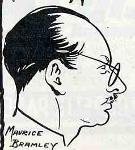Maurice Bramley came to prominence as a commercial artist relatively late in life. At the time of his marriage in Sydney on 18 August 1925, Bramley gave his stated occupation as 'cable operator' and his usual place of residence as Auckland, New Zealand. Bramley's earliest known published work dates from the early 1930s, when he worked as an illustrator on The World's News, a weekly periodical combining news stories and short fiction, published by Associated Newspapers (q.v.).
Bramley arguably remains best known for the wartime recruitment poster 'Join Us in a Victory Job', which he painted on behalf of the Department of National Service in 1943. Bramley's poster design was used as the cover illustration for Patsy Adam-Smith's (q.v.) book Australian Women at War (Thomas Nelson, Melbourne, VIC, 1984) and was issued as a stamp by Australia Post (q.v.) in 1991 to commemorate the 50th anniversary of Australian women's wartime services.
From the mid-1940s onwards, Bramley painted and drew covers for many of the crime, science-fiction, and western pulp novels issued by Transport Publishing (q.v.), particularly for the Scientific Thriller series (see Master-Mind Menace) and Bullseye Western Monthly Magazine. Bramley briefly worked as a freelance illustrator for Calvert Publishing (q.v.) during the early 1950s, producing covers for their Six-Gun Western series (see Desert Duel). Nonetheless, Bramley maintained his association with Transport Publishing throughout the 1950s and 1960s. Bramley drew hundreds of covers for the firm's range of US reprint comics (e.g., Buffalo Bill, Crime Busters, Battle Action), and frequently recycled many of his earlier pulp novel paintings as 'new' comic-book cover designs.
Bramley used his wife, Adele ('Dell') Cox-Taylor, as a model for many of the women depicted in his pulp cover paintings. (Adele was the niece of Margaret Cox-Taylor [q.v.], a journalist who wrote under the pseudonym 'Vandorian'.) In the 1950s, Bramley relocated to Tuross Head on the New South Wales coast, where he used several local residents as models for characters depicted in war comic books he drew for Horwitz Publications (q.v.).
In 1959, Bramley replaced John Dixon (q.v.) as the writer and illustrator on The Phantom Commando (1959-1965), the last Australian-drawn comic book to be issued by Horwitz Publications. During the early 1960s, Bramley drew several instalments of a western series, 'Sudden', for The Fast Gun comic book (Horwitz Publications, ca. 1960-1962). Bramley's strip, which was loosely based on the 'Sudden' western novels first written by the British author Oliver Strange in the 1930s, last saw publication in the early 1970s, when The Fast Gun comic book was reissued as a 'show bag comic' by Page Publications (q.v.).

